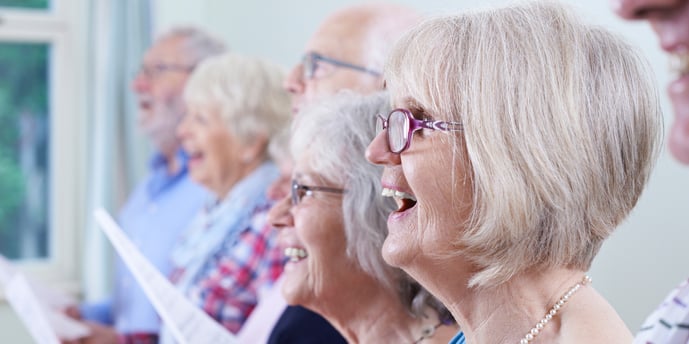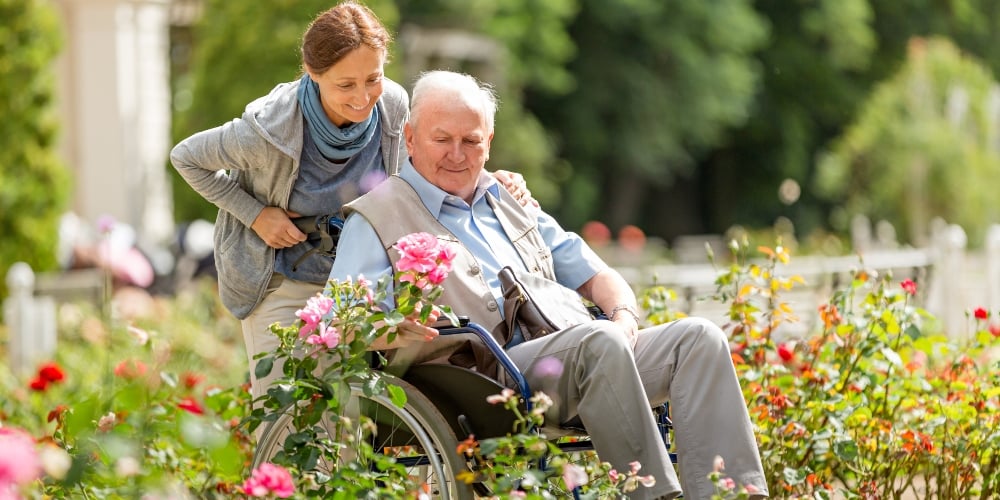
Music is a powerful tool. It can lift your spirits, encourage you to be active, spark memories, and connect you with others. This is especially true for people with memory loss.
Although everyone’s experience with dementia is unique, research shows that musical memories are stored in a part of the brain that is one of the last to be affected by memory loss. The music you grew up listening to, the song that played on your wedding day, hymns you sang at church — they’re among the last things you’ll forget.
Songs from the past can not only stir powerful emotions and transport you back in time, they can also relieve stress and reduce anxiety and depression. Singing songs and listening to music are things everyone can participate in, regardless of age or ability.
That’s why music is such an important part of Highgate’s holistic approach to memory care.
“Many communities are one-trick ponies, and the trick is to go to the doctor to get a pill,” says Marcie Suppe, Director of Resident Services at Highgate Senior Living. “That’s not always necessarily the best thing. For someone who is agitated, maybe it would be much better to listen to music to calm down.”
Adds Life Enhancement Programming Manager Angie Larrabee: “Music is a very important component to our programming. Our goal is to have music at least twice a day. It’s so powerful in how it can bring residents out of their shell and participate more than they normally would, especially when one of their favorite songs is playing.”
Here’s a closer look at how Highgate uses music as medicine to help people with memory loss live life to the fullest.
Music and Motion
Walk into The Cottage memory care neighborhood at Highgate at Bellingham during music therapy and you might see a group of residents in a circle raising pool noodles like batons, conducting a John Philip Sousa march.
“It’s like a group of sea anemones swaying in the current,” says Life Enhancement Coordinator Christal Seitz.
They’re participating in Conductorcise, a “workout for the mind, body, and soul” created by clarinetist and conductor David Dworkin. Conductorcise invites participants to raise a baton (or a pool noodle) and physically respond to music like conductors, offering residents the chance to move, dance, rock, and sway to everything from big band music to operatic classics.
“Residents can be more passive or get really into it and feel the music go through their bodies and move to their arms to feel that full extension and passion as they are actually getting a great workout along the way,” Larrabee says.
Seitz and the rest of the Life Enhancement Team also teach residents about the lives and work of great performers. It’s one part aerobic workout, one part symphonic performance, and one part music history lesson.
Most of all, “Conductorcise is just like big, ridiculous positivity,” Seitz says. “It’s one of those activities that’s a surefire way to turn around a bad day. It’s hard to be in a group of positive, happy people without that being infectious.”
The residents who can safely get up on their feet are standing, and those who are sitting do their best version of the movements. Care partners often walk around the circle using the hand-under-hand technique (which is like supportive hand-holding) to help other residents get movement going. Frank Sinatra, Perry Como, and Buddy Holly are among the residents’ favorite artists.
“When you feel them start to take the beat for themselves, that’s really great,” Seitz says.
Therapeutic Singing
Over at Highgate at Vancouver, you might hear memory care residents participating in a call-and-response singalong. Called SingFit, the program offers access to hundreds of songs curated by music therapists, and the songs include lyric-coaching that gives the singers the words right before they need them.
Often, songs will be more than singalongs. The Life Enhancement Team will also include trivia, reminiscence questions, and movement activities.
“Who is one of the most famous trumpet players from New Orleans … ,” a Care Partner asks. “Satchmo!” a resident interjects. Then the group sings along to “When The Saints Go Marching In” complete with foot stomping and sharing stories about trips to New Orleans and playing the trumpet.
“We’re very active in mannerisms, in moving the body, in trying to make a connection with the residents,” says Rose Zamudio-Mora, Life Enhancement Coordinator at Highgate at Vancouver. “We’re using a lot of facial expressions and eye contact to make it exciting.”
The result? Residents come alive.
Research shows that three SingFit sessions per week increased mood by an average of 43 percent among memory care residents, and one adult day care facility noted a 40 percent reduction in the need for anti-anxiety medication in SingFit participants.
“You put on this music and you see their eyes open up,” Zamudio-Mora says. “Music stays with them. It has a connection in their brain. It’s something that brings them to where you’re at.”
Making Connections
Board-certified music therapist Trina Rainey has been coming to Highgate at Bozeman to offer weekly music therapy sessions to memory care residents for nearly 15 years.
“I love providing interaction, stimulation, validation, conversation,” she says. “Music engages them in ways that sitting down and talking doesn’t.”
For example, when Rainey picks up her guitar and starts playing a familiar song like “You Are My Sunshine,” residents start tapping their toes. The music and repetition of the song get their neurons firing and cause their brains to release dopamine — the happiness hormone.
“When they start feeling good, all of a sudden, they’re like, ‘Oh, I remember this!” she says. “And guess what, the folks with Alzheimer’s don’t often have those moments of, ‘Oh, I remember this’ or ‘Oh, I can do that.’”
Rainey says it may look like they’re just having lots of fun making music with maracas, bells, tambourines, and drums and waving and dancing with chiffon scarves. However, music therapy is way more than that.
“There are so many goals I’m addressing,” she says. “I’m looking specifically for eye contact and motor movement and memory recall. For instance, if I sing ‘You make me happy when skies are … ’, they fill in the blank.”
Or if they’re singing “My Bonnie Lies Over the Ocean,” Rainey will ask questions to get the residents reminiscing: Has anybody been to the ocean? Has anyone been on a boat?
“And then you get stories,” she says. “‘Well, I lived in California.’ or ‘I served on a boat in the war.’ There’s a social aspect to reminiscing. That song is also a waltz. Has anybody ever gone waltzing? All these things can come out of one little simple song.”
Due to COVID-19, it’s been a while since Rainey has been able to offer music therapy at Highgate, but she still recalls Glenn and Ruth, a couple who live at Highgate at Bozeman thanks to the Couples Care program: “Ruth is pretty confused most of the time, and Glenn is always worried about her. When I come in, she plays the tambourine and sings all the words to all the songs, and he just dotes on her and says all these loving beautiful things. It’s almost like they forget that she has Alzheimer’s, he forgets his physical ailments, and they just sit there and hold hands. Even though she might not remember his name or where they are, it’s this beautiful glimpse of the love they have. It's completely supported and validated through music. It’s like going back in time to when they first met. It happens every time. It’s amazing.”
“The music is the bridge that reaches deep into their heart, mind, and soul,” Rainey continues. “It’s incredible to be able to connect in that way.”
How to Use Music to Help a Loved One with Memory Loss
If you’d like to use music to help a loved one who has dementia, here are some tips from the experts at Highgate.
1. Speak in a Form of a Song
If your loved one has Parkinson’s, they might find themselves “locked” and unable to walk or express themselves verbally.
“If you put your words to a beat, you might find more success in getting them to do what is being asked of them just because of the use of the rhythm and movement that goes with the music, Larrabee says.
For example, try singing “We’re walking down the hall” to the tune of “The Farmer in the Dell.”
Research also shows group singing can improve the quality of life, voice strength, and clarity in people with Parkinson’s disease.
“Sometimes someone has a hard time expressing themselves verbally, but they still have a sense of rhythm,” Seitz says. “We have residents with Parkinson’s who are suddenly singing or talking to a beat.”
2. Offer Choices and Allow for Preferences
People with memory loss may have difficulty making some decisions, but whenever possible try to support them in making their own decisions.
Music offers many opportunities for this. For example, instead of simply putting on the Beach Boys, why not ask, “What songs should we sing?
Another way to honor personal preferences would be to ask a question such as, “Would you like to hear Frank Sinatra or Elvis Presley?”
3. Don’t Sweat the Small Stuff
It can become increasingly difficult for someone with dementia to find the right words to finish a sentence. However, pointing out their mistakes can fuel an already frustrating situation.
Singing allows for creativity. “If I knew you were coming, I’d have baked a cake” becomes “If I knew you were coming, I’d have cleaned the house,” don’t sweat it.
For more tips on caring for an aging parent, subscribe to Highgate Senior Living’s monthly newsletter, Purposeful Living, today.





